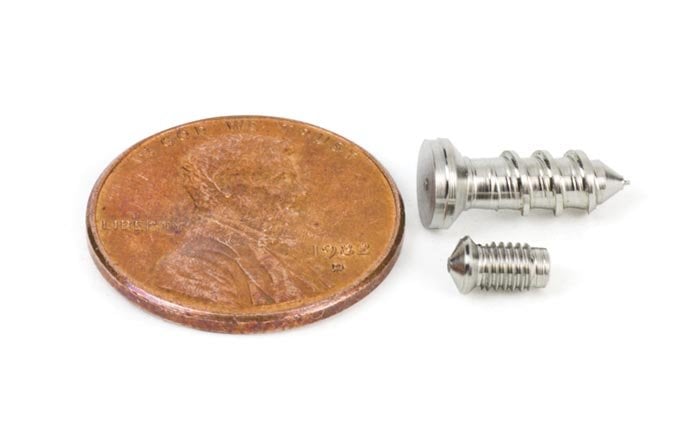Lukas Eiserman, owner and president of Eisertech, LLC—manufacturer of spinal implants and surgical instruments—uses PCNC as a core part of his business. What started as prototypes in Eiserman's home garage are now improving the quality of lives across the United States.
With a background in Biomedical Engineering, Eiserman learned CNC on the job at his own company. "I started a medical device company back in the '90s and we had gotten a machine shop going up there. One afternoon when we had a big order due, one of the machinists quit. He was the only guy who knew how to program the CNC lathe. I thought, 'We're either going to lose this big customer or somebody's got to run this job.' So, I sat down with one of the other machinists and the programming manuals and we figured it out." Building on his credentials in medical device and biotechnology, Eiserman eventually moved to Southern California and found himself working in the spinal implant industry. "I've been pretty involved in patenting things throughout my career. So I started shopping around for something to make prototypes and was kicking around maybe getting a rapid prototyping machine. But then I thought, I'm still stuck contracting out the machining work and it's all supposed to be new and patentable stuff. I need to be able to make two of one thing then I'll wait three months for a vendor to and I'll never get anything done," he recalled. "So, I started looking for a small CNC machine. At the time I was working out of my garage and my basement office and was looking for something small enough too that it could fit the space I had without taking over the whole garage. I was searching around the internet and saw Tormach and a few others out there. It seemed like the PCNC 1100 was the heaviest duty machine in its class, and so I went for that one." Eiserman continued, "I bought the PCNC 1100 to do some prototypes, patent a few things, and then shop them around to a couple of the other implant manufacturers. It wasn't very long before a few orthopedic surgeon friends talked me out of that idea and encouraged me to start an implant manufacturing company. So, I ended up with a Tormach mill and what I thought would just make a few prototypes is running production implants now." Also purchasing Duality Lathe to prototype titanium bone screws and stainless steel surgical instruments, Eiserman added, "I got the Duality Lathe thinking I'd make a few prototypes and that should be good enough—if it took a long time and I had to struggle with the part a bit, it wouldn't be a big deal because I'd only be making one or two. And then suddenly I found myself having to make 100 screws and to take the little quick change tool post and swap it out and put the next tool for the part. I was using four or five tools per part and I was running them on titanium, so I'd have to jerry-rig the setup to get some coolant on there and I was getting soaked." Out of necessity, Eiserman designed a gang tool setup for the Duality Lathe with a coolant manifold and mounted it to clamping spindle collar on the PCNC 1100. "I found myself in the situation of trying to get the Duality Lathe to do something it was never designed to do," he said. "I thought if I had a little gang tool on there, I wouldn't have to do tool changes and I wouldn't have to screw around with the little quick change tool posts." Eiserman continued, "I thought, 'I've got this thing mounted in the table and it does Y-offsets, so I'll try to see if I can do a Y-offset in the Duality Lathe software; and sure enough it let me get away with it.' At first I started using the Y-offsets to compensate for little tool posts, but they were not staying put, so I cranked them all the way down and associated a Y-offset with each tool number. And then I thought, 'Well, why don't I just re-do this clamp fixture around the spindle nose?' So I drew up a just fixture for that and thought I'd give it a try. Actually, that first prototype I made is the one I'm still using now. It's so much more stable and is rock solid. I can put tools that need a heavy cut much closer to the column, so I can get less vibration on it." With six up-and-down working stations and eight end working stations, Eiserman uses his tooling collar gang plate to run production work on the Duality Lathe, "It's certainly made life a lot easier. I can park a couple of tools on there without any required tool changes. I also put an enclosure around the mill now, so I can splash the coolant better. I don't open anything now; I start the cycle and it just goes." With the first round of approvals from the FDA last fall, Eisertech spinal product sales have been steadily growing in the United States. "We're just getting started," Eiserman said. "I put the first product up for sale in November and it's very much a relationship and word-of-mouth business. It's slowly, but surely, picking up and it's getting a nice positive reception." "The group that's really receptive is smaller surgical centers where the physician, or group of physicians, is the sole owner. They're now managing all of their own equipment and are truly small business owners. They love the model because they can go home at night and shop for their implants and it's such an easy thing for them to do."


